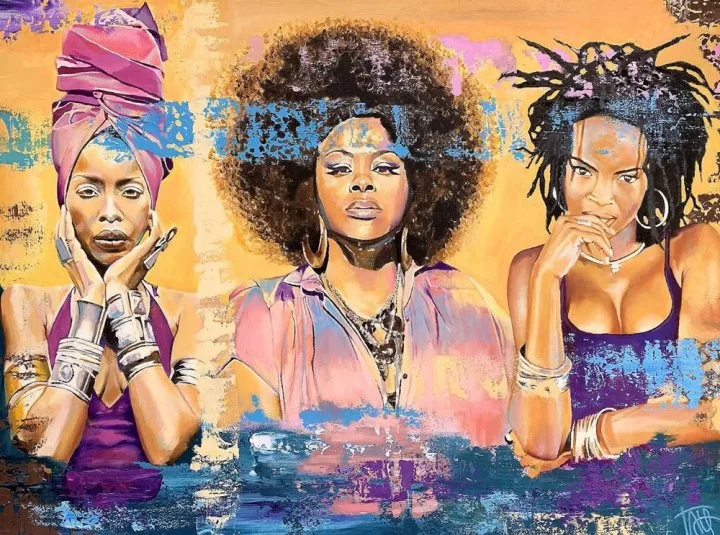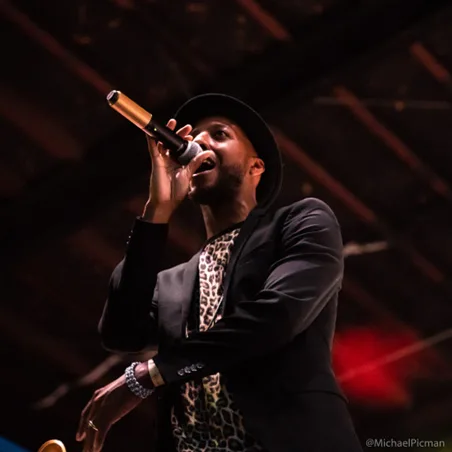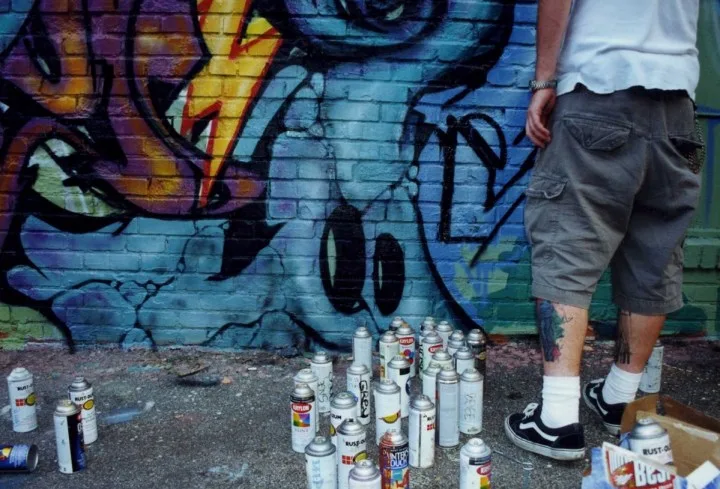DJ Joc Max along with Ta-Ha from Basement Khemists and producer Tommy Lift. “This photo was taken sometime in the late 90s early 2000s at the Brick in the Crossroads KC. Joc Max is an amazing DJ and producer. He’s one of my faves and definitely deserves recognition as a pioneer here in KC.” (photo and remarks by Phil “Sike Style” Shafer)
A look at Kansas City’s contribution to the art form in conjunction with its 50th anniversary
This article is the fourth in a series titled “The Art of Blackness.” Says author Harold Smith, “Like assemblage created from found objects, many iconic cultural elements in the Black experience — notably in areas of music, food, hair, clothing — lie at the intersection of both African and American cultures. Like the ‘Big Bang,’ this collision of African creativity and American captivity resulted in an explosion of new ways of personal expression that still reverberates in Black American life.
“As a result, simply experiencing life as a Black American is an artistic endeavor.”
“I’ve been a hip hop head for a long, long time. When I listen to it, I hear blues, jazz, soul, and the beats of Mother Africa. When I look around, I see its imprint on American culture. Hip hop is etched into the American identity. Not just black, but all of America . . . and the world.” — Glenn North, poet, educator
It was 1979. Gas was cheap, the Royals were winning and Arrowhead Stadium was never sold out. I was 16 years old, nerdy as hell, 150 pounds soaking wet and making pizzas at a now-closed Pizza Hut on State Avenue when I first met hip hop. A song called “Rapper’s Delight” by the Sugarhill Gang came on KPRS one cool Friday night. At the time, most of us were really into Parliament Funkadelic, LTD, The Gap Band, Barry White and anything funky with soul.
“Rapper’s Delight,” now ranked at number 251 on Rolling Stone magazine’s list of the “500 Greatest Songs of All Time,” was a rollicking funky vibe with an entirely different aesthetic. In this song, the words, spoken with precise, lively cadence and rhythm, were music in themselves. With its intriguing but catchy lyrics wrapped in a New York vernacular, it initially felt strange, and we stopped momentarily to make sure we were hearing what we thought we were hearing.
However, by the time Master Gee began his verse with “Well it’s on and on and on, on and on. The beat don’t stop until the break of dawn,” Theodis (the other cook working that night) and I were bobbing our heads to the beat and moving to the rhythm as we rolled out pizza after pizza.

2023 is the 50th anniversary of hip hop. Researchers have traced the birth of the music back to Aug. 11, 1973, and a back-to-school party in the Bronx deejayed by Clive Campbell, otherwise known as DJ Kool Herc. In the five decades since, it has come to dominate the worldwide music industry and become an indelible part of sports, entertainment and even politics. North was right when he said, “Hip hop is etched into the American identity.”
A July 2, 2023, Pitch article, “50 Years of Hip-Hop in KC: A history of our first half-century from house parties to Hammer Time to Tech N9ne,” explored Kansas City’s hip hop history from the early 1980s to the present. A must-read for anyone interested in KC’s musical history, the article covers hip hop in Kansas City from days of early hip hop parties at the old Lincoln High, to modern times and individuals like local rap legend and mogul Tech N9ne, regarded by many as the most successful independent hip hop artist ever.
Shawn Edwards, award-winning journalist for FOX 4 News in Kansas City, Missouri, and one of the country’s leading African American film critics, is an authority on local hip hop. In celebration of the 50th anniversary, with 18th and Vine Lives, he co-organized a hip hop concert on Aug. 12 at the Gem Theater. He also created a Spotify playlist titled “The Fountain City” that featured the best rap songs out of Kansas City.


Kemet Coleman, formerly known as Kemet the Phantom, the founder of Vine Street Brewery, is a fixture on Kansas City’s hip hop scene. A graduate of Raytown South, he finished his first album as a high school sophomore. In the years since, with multiple albums and mixtape releases under his belt, the former UMKC Urban Studies major has cemented his position in Kansas City’s hip hop scene as both an artist and an entrepreneur. His titles have included CEO, marketing director and digital media specialist, among others.
Consistent with the Black musical tradition, Coleman’s work is influenced by his church background. “I grew up in the church. Actually, it was two churches. I sang in the choir. So, even if I tried I wouldn’t be able to keep the influence out of my work. My vocals and singing style are definitely church influenced,” Coleman says.
The son of a civil rights attorney, Coleman derives musical inspiration and influence from various avenues. “My style is gumbo. I’ve performed with the Marcus Lewis Big Band (jazz). I sing and rap. I do my own hooks. I like to mix vocals, styles, wordplay, and stuff like that. I chop, which is called fast rap. I make my own beats too. My beats are a mix of house music, jazz, soul, gospel, and pop. I like to make dance music. On the political side, I drop songs that speak to current events and the way the world is going. To be honest, I treat it as therapy,” he adds.
An even-spoken and pragmatic individual, Coleman makes waves on a national level too. “Get Out (The Streetcar Song),” a tune about the KC streetcar, was described as “outrageously funky” by The Atlantic and listed as an “Essential Transit Tune.”
The same way KC makes waves on the national hip hop radar, KC is itself influenced by hip hop from across the country. “There is definitely a Bay Area influence in the music here,” Coleman says. “The jazz influence can be heard in the lyricism here. Chopping and fast rapping are pretty big here too.”

Origins of Hip Hop
“Hip hop to me is the celebration and storytelling of Black culture through music. It has a big influence on my art because much of my work is created with hip hop music playing in the background. It’s a main source of fuel for my creative process. I am inspired by the vulnerability of the musical artists, and I aim to create that same kind of raw emotion through my art.” — Tayler Sanders, painter
Hip hop, like other Black art forms, is born of perseverance in the face of poverty and resilience in the face of rejection. In the absence of access to musical instruments, early hip hop artists used everything from aluminum garbage cans, bottles, soda cans, discarded pallets, dinnerware, and even their mouths to imitate percussion instruments in the artistic form called “beatboxing.” This ingenuity in the production of music and presentation of content has created a subculture that, like soul food taking unwanted scraps and creating masterpieces, is a cultural masterpiece complete with its own vocabulary and coded language.
The ingenuity of hip hop extends beyond the music: Its artists have used their musical success to launch clothing labels, liquor brands, cannabis lines, restaurants, scholarship programs, charter schools, etc. Kansas City is no exception. Coleman, with his partners Elliott Ivory and Woodie Bonds, Jr., officially opened Vine Street Brewing Co. June 30. Determined to bring the joy of craft beer to diverse communities, the trio has launched an airy space that includes a taproom, brewhouse and outdoor beer garden.
Local icon Phil Shafer, also known as Sike Style, is a nationally known muralist, graphic designer and public artist. A former DJ and promoter under the name Sike Steez, Shafer was raised in Brooklyn during the golden era of graffiti and hip hop. Often collaborating with Daniel Bartle (aka Lucid), Sike Style has collected event flyers and photographed local hip hop for decades, creating an exhibition-worthy archive related to Kansas City’s hip hop history.
Shafer, a graduate of the Kansas City Art Institute in new media, has been involved in local hip hop both on stage and behind the scenes. “My true calling was designing local album covers, fliers, and band merchandise like t-shirts. Once I stopped Dj’ing, I attended most shows and still documented key events I was a part of. I still design custom artwork for events,” he said.
He adds, “KC Hip Hop has lots of people to thank, a lot of points of view, a million stories, and they live on strong ’til this day by sharing. Keep supporting your local artists and remember: Hip Hop is Not a Crime!”
Note: In celebration of hip hop’s 50th anniversary, the Saint Louis Art Museum is presenting a major show, “The Culture: Hip Hop and Contemporary Art in the 21st Century,” through Jan. 1. For more information, www.slam.org.


